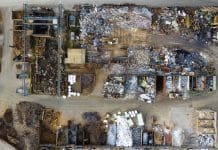Environmental solutions and safeguarding our planet for future generations have always been at the forefront of projects undertaken by Land & Water. James Maclean, CEO of the UK’s leading wet civil engineering firm, explains what steps the civil engineering industry can take to clean up its act
Many businesses, specifically those within the construction and civil engineering industries, are under pressure to implement more sustainable practices. The Government has challenged all businesses to become net carbon neutral by 2050. The Environment Agency wants to reach this target and meet the goal of net zero by 2030, an objective Land & Water is also striving to meet.
Driving environmental change within the civil engineering sector, Land & Water has already introduced some innovative sustainable solutions, launched a carbon reduction agenda and added value to the areas in which it operates. Here we look at some vital strategic and behavioural changes the civil engineering industry can make to become more environmentally sustainable.
Making inspired changes at the thinking, planning, design and delivery stages
Firstly, to achieve the giant step of becoming net carbon neutral, we need to make inspired changes at every level of thinking, planning, design and delivery of each project. It’s all about making smart moves to improve our environment.
At Land & Water, we are continually developing our approach, trialling new products, and fine-tuning the performance of our machinery. Our industry needs to put decarbonisation at the top of its agenda; future generations depend on the decisions that we make now.
It’s no secret that the construction and civil engineering industries are key producers of CO2. But it goes beyond diesel consumption, and so it is about time that the sector looks at its waste removal too.
Reducing the impact of climate change
In the initial planning stages of every project, here at Land & Water, we consider different ways of reducing our environmental impact at every level. For example, do we even need to deliver the project, or can we improve and maintain our waterway and estuarial infrastructure differently? Is there a way to support nature recovery within this project by reusing spoils and sediments and ultimately reducing the impact of climate change?
A huge part of Land & Water’s ongoing environmental commitment is not only to reduce carbon, but also to add value to the areas in which we work, further safeguarding our planet for years to come. As we leave a project behind, we always look to build in nature and create a habitat that encourages net biodiversity gain and carbon sequestration at the point we have infringed.
By repurposing spoil, we can reduce reliance on landfill sites, cutting waste – and ultimately emissions – to increase biodiversity. While adhering to the regulations in place when it comes to the re-use of spoil and dredged materials, being smart and forward-thinking can create huge environmental improvements.
Since 2015, Land & Water has been working with the Port of London Authority (PLA), RSPB and Natural England to use redundant, non-hazardous materials to create landforms along the East London Corridor. This collaboration will see us operating the 152 hectares of silt lagoons until 2042, resulting in over six million tonnes of wet and dry spoil material repurposed and 1,000,000m2 of valuable habitat being created. This is real ‘natural capital’ being created at no cost to the taxpayer.
Making offshore waste removal more sustainable
We are also looking to change behaviours regarding offshore waste removal. Currently, 99.5% of coastal dredged materials are being disposed of offshore by dredging contractors, and this needs to change. Not only can this damage wildlife, but it also has potential detrimental impacts to our sea bed and sensitive sea-scape habitats.
The rise in sea levels, increased boat traffic, alongside higher intensity storm events, and the removal of sediments (by dredging) from local estuarial “cells” are all negatively affecting our sensitive coastal habitats.
There have been significant impacts on seagrass fields and sensitive inter-tidal habitats, including salt marshes, where we can demonstrate losses along some parts of the south coast of more than 50% of the habitat, compared to 1946 aerial photographic records. It is time for civil engineering and construction contractors to acknowledge their part in this outcome.
Protecting shorelines against coastal flooding with salt marshes
Salt marshes are vital for protecting our shorelines and reducing flooding. They are also highly efficient absorbers of nitrates and phosphates and up to seven times more efficient at absorbing CO2 than woodlands (per ha). This means they are an important component in the drive towards the carbon net zero strategy and efficient platforms for providing nutrient neutrality and biodiversity gain, as well as being an integral part of the coastal defence against storm surges.
Land & Water is proud to announce that it is working with Chichester Harbour Conservancy and Lymington Harbour Commissioners to conduct full scale trials next winter to recover over 10,000 metres sq of salt marshes.
This is part of our commitment towards using salt marshes, as well as vacant and derelict land, to transform them into high value ecosystems. We have also designed and built a specialist piece of new equipment, developed to help us carefully transport dredged sediments from sea going vessels onto the depleted saltmarshes above Mean High Water.
We sincerely hope our trials help reaffirm the use of new technologies to help change historic practices and help us play our part in the responsible use of the planet’s resources to promote nature’s recovery.
Land & Water prides itself on delivering a circular economy model in everything it does and this is one way the company can ensure it is safeguarding the future of our environment for years to come.














